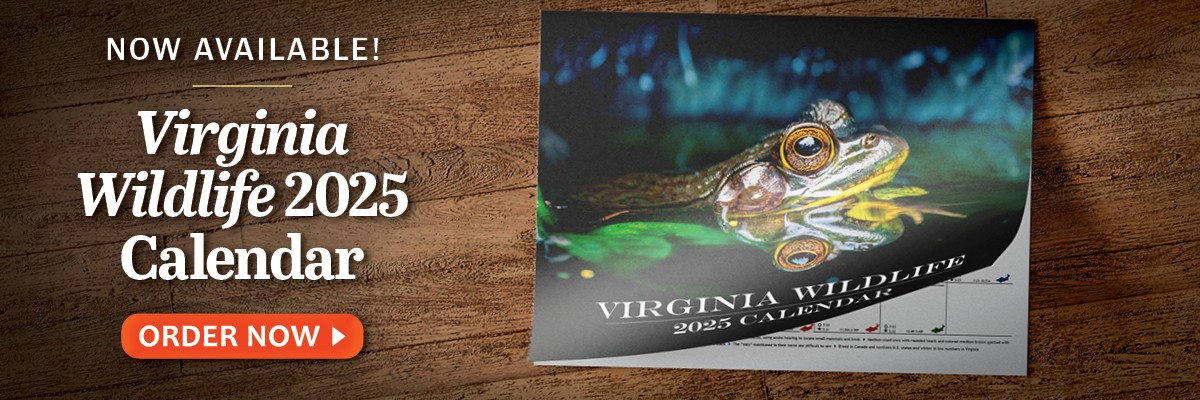By Molly Kirk/DWR
For the final species in our series celebrating the 50th anniversary of the Endangered Species Act (ESA), we’re looking at a species that the ESA’s protections have helped back from near extinction. In fact, with decades of stream restoration and fish passage projects, the Roanoke logperch (Percina rex) looks as if it might be on its way to possibly be de-listed from the federal Endangered and Threatened Species List.
“We have seen improvements in populations, and we’ve found these animals in more locations. A lot of habitat work has contributed to its recovery,” said Mike Pinder, Virginia Department of Wildlife Resources (DWR) nongame aquatics biologist. “The wheels are moving for the Roanoke logperch to be on the road to being delisted, which is a real success story.”
A bright, colorful fish that can grow to up to six inches long, the Roanoke logperch is a “charismatic little critter,” according to Pinder. “Rex is Latin for king, and this is the king of the darters.” Like most other darters, it lives on the bottom of streams and rivers and skims along the bottom on its belly. Large pectoral fins help it stay low in the water, and it’s very hydrodynamic in shape.
Pinder noted that the logperch group of fish “have a characteristic elongated snout, which is suited to the behavior that you just don’t see in other fish. Most fish, like trout, will just hang around, waiting for food to just float down to them. But logperch take a more active role—they flip rocks with their snout looking for little aquatic insects that live underneath—the mayflies, caddisflies, and stoneflies. So prolific is their quest for a meal, you’ll see some of these older logperch with a white callus on their snout due to all the rock flipping.”
See DWR’s species profile of the Roanoke logperch, which includes a video of its rock-flipping behavior.
With its blotchy green-gray body and scrawled back, the Roanoke logperch doesn’t have the vivid primary colors of some other darter species. But during breeding season, mature males’ dorsal fins and spots turn bright orange.
Once considered endemic to Virginia until a North Carolina population was discovered a few decades ago, the Roanoke logperch can be found in larger streams and rivers in the upper Roanoke, Smith, Pigg, Otter, and Nottoway river systems, and Goose Creek in Virginia and in the Dan, Mayo, and Smith river systems and Big Beaver Island Creek in North Carolina. They prefer large, warm, clear streams and riffles, runs, and pools with sand, gravel, or boulder.

Streambank restoration projects such as these can turn eroded banks and muddy water (left) into vegetated banks and clear water (right), benefiting a wide variety of aquatic and terrestrial species. Photos by Mike Pinder/DWR
Threats to Roanoke logperch populations echo those to other aquatic species—the classics being pollution, dams, and non-native species. The ESA’s protections have helped mitigate some of those threats, especially the pollution and dams. “We’ve been very proactive for any projects that are working in waters where these animals are present, making sure that the work is done outside spawning season and that appropriate controls are put in place to prevent any negative impacts,” said Pinder. “We’ve also partnered with farmers and private landowners to conduct stream restoration projects to improve water quality.
Stream restoration strategies include repairing the banks, installing in-stream structures to divert water from eroding banks, and establishing vegetated riparian buffers. Those projects help prevent soil loss and subsequent sedimentation, improving the water quality. Farmers voluntarily agree to limit cattle access to streams while being provided an alternate water source. DWR works with the U.S. Fish and Wildlife Service (USFWS) on those cooperative projects, which include funding enabled by the ESA.
Removal of obsolete dams from waterways helps threatened or endangered species, as it allows unobstructed movement of fish from one population to another, thereby expanding genetic diversity. It also opens up new habitat for all fish species and eliminates a potential hazard to boaters and swimmers.
DWR biologists and their partners have worked for decades to locate and monitor populations of the species, expanding their knowledge of the species’ range. That information is crucial to know before conducting reintroduction efforts. “You have to do a lot of research to make sure you’re doing it right,” he said. “Back in the day, fish were stocked with little regard to genetics. We know that different populations can be genetically unique, so we have to be more thoughtful in what we do. North Carolina biologists have come up into the Smith River drainage in Virginia, with permits and our approval, to get some broodstock for their propagation work on Roanoke logperch. We know that they can’t go into the upper Roanoke River system to get them because those genetics would be too separated, so they find fish that will work genetically with their populations.”
Restoring the species has been made possible by all the stream restoration and dam removal work that’s been done by public and private partners to improve water quality. And the Roanoke logperch certainly isn’t the only species to benefit from it. “If you’re reducing sediment into the stream, you’re improving aquatic insect communities, you’re improving non-game fish communities, and that’s going to positively affect game species like bass and trout,” said Pinder.
“Then, all that good water quality is going downstream benefiting citizens in Salem and Roanoke that use water from the Roanoke River as a drinking source. This eventually flows down into Smith Mountain Lake which also benefits from these improvements,” Pinder said. “You might think that improving water quality is only helping this particular fish, but actually, it’s a lot bigger than that. It’s all interconnected.”


